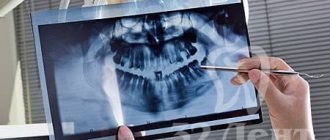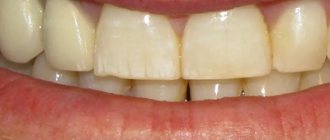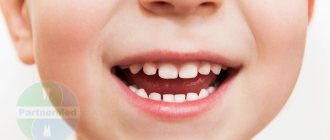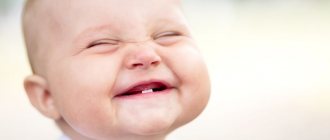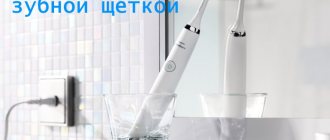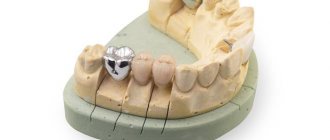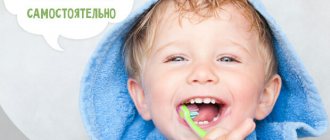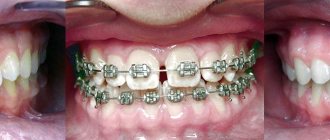From the moment children's first teeth appear, they need care. Dentists recommend teaching hygiene procedures as early as possible, but they do not recommend imposing a healthy habit. Experienced mothers know that getting a child to brush their teeth is very difficult. Children are capricious, express dissatisfaction and resist. To solve the age problem, special tricks and educational approaches are needed. To make the new procedure a favorite pastime, start by finding out the reasons for your reluctance to brush your teeth. This could be a hard brush, painful sensations, ordinary laziness, or the goal is to attract attention when there is a lack of it. Eliminate all irritating factors and try to come to an agreement with your baby.
When to start brushing your baby's teeth
Hygienic care is necessary even before teething. The procedure must be carried out several times a day: after sleep and during the day after feeding.
The procedure for cleaning your baby's gums is as follows:
- place the child on your lap;
- take a gauze swab and carefully walk it over the surface of the gums. For greater convenience, you can wrap your finger with a bandage or use special finger pads, which can be purchased at the pharmacy.
It is enough to simply moisten the tampon with clean water, but for greater effect you can use foam designed just for such purposes (for example, SPLAT Junior (SPLAT Junior) for children 0-4 years old).
Foam is a modern, effective product that has many beneficial properties. Firstly, it contains lactic enzymes that protect the mucous membrane from infection and bacteria that cause various diseases (for example, stomatitis). Secondly, components such as creatine, arginine and others have an anti-inflammatory and calming effect, reducing pain during teething. Thirdly, many foams contain calcis or fluoride in small dosages (the former are best used before a year, the latter - after).
First year of life
When you hear the ringing sound of a spoon touching the first incisor, do not rush to run for a brush.
For infants up to one year old, there are their own care products:
- silicone fingertip;
- sterile bandage;
- dental wipes.
The advantages of the listed means are that they are worn on the finger. This allows you to feel the gums and adjust the pressure.
The most inexpensive way is to use a bandage or gauze soaked in water or soda solution. A small amount of bandage is moistened, wrung out and wrapped around the finger. The gums, tongue and inner surface of the cheeks are treated.
Purchasing dental wipes will hit your pocket much more. They are intended for one-time use, treated with a special antiseptic solution that is safe for the baby. Neutral in taste, will not leave any unpleasant sensations in the baby.
Children's stores have a huge selection of silicone fingertips. For the first manipulations, it is better to choose a smooth attribute.
For older babies, you can offer finger pads with silicone bristles. They are more reminiscent of a toothbrush and massage the gums better. After each use, wash in running water. Boil before first use.
Brush your child's teeth correctly
Teeth begin to erupt at about 6 months of age. Some children easily survive this period of time, others suffer from pain and experience great inconvenience.
Emerging teeth can be cleaned, just like the gums in the first months of a baby’s life: take a gauze swab, apply a special foam to it and rub it over the surface of the gums and teeth. Sometimes you can find finger pads with soft bristles on sale: they make the procedure much faster, better and more convenient.
Perhaps the baby will not like the procedure at first: you should not force things - it is better to give the child the opportunity to get used to it. When the baby is no longer nervous at the sight of tampons, you can move on to using a brush (there is no exact time frame for when exactly this should be done). You can hear from some dentists that it is advisable to use a brush after the appearance of at least 4 teeth in a row, others advise not to rush, waiting until the baby is 2 years old.
Child 4-5 years old
By the age of 4-5, many toddlers have already developed a stable habit of brushing their teeth. And parents can begin to draw their attention to the quality of the procedure.
Be patient. You are unlikely to be able to immediately teach your child to take care of his teeth. And that's okay. Moreover, for several more years (approximately until the toddler reaches school age) you will have to control the process itself. Since the baby still cannot properly brush his teeth on his own.
Brushing your teeth
Cleaning should be done after waking up and before going to bed. The duration of the procedure is at least 2-3 minutes. Particular attention should be paid to chewing teeth, since they contain small grooves where bacteria accumulate and caries begins to form.
Not all children enjoy brushing their teeth: some may become capricious, nervous, and break out. First of all, you need to make sure that the fear goes away: brushing your teeth can be turned into a game, for example, you can let your child brush your teeth, and you brush them for him.
High-quality toothpaste and brush are of no small importance for hygiene, but their use is clearly not enough: once a day you need to floss (by the way, this advice applies not only to children, but also to adults). Floss can remove small food debris from dental spaces that are difficult to reach with a brush. Carious formations appear primarily in such places, since an excellent environment for the growth of bacteria is created there.
Which toothbrush should you choose?
Children's toothbrushes, without exception, have soft bristles. It is distinguished from an adult brush by a smaller head, which can be rubberized, which is done to reduce the risk of injury during the cleaning process.
The packaging of most brushes for children contains information about the age they are intended for: these recommendations should not be neglected. It is better to choose a brush with an unusual design that can attract the child’s attention and make him more willing to brush his teeth.
The brush should be changed once every 3 months, or better yet more often: you need to monitor the condition of the bristles, and not hesitate to replace them when they begin to deteriorate. The point here is not only the lack of aesthetics, but also the loss of functional qualities: if the bristles are fluffy, then it will be difficult to remove plaque, which is fraught with unpleasant consequences.
Each family member should have their own brush!
Recently, electric toothbrushes have become increasingly popular. There are special children's brushes that can be used after 3 years. Practice shows that children show more interest in electric toothbrushes than in regular ones. Again, each child should have their own personal attachment.
What is the importance of caring for baby teeth?
According to average data provided by WHO, the first teeth erupt at six months, and according to some data, at four months. A complete primary dentition is fully formed by the age of three. By this age, the child should have 20 teeth in a set.
The myth that temporary teeth do not require special care and do not need treatment is nothing more than a relic of the past, and a rather dangerous one at that. Even if the baby does not suffer from pain and discomfort in the oral cavity, the problem absolutely cannot be ignored! Children, just like adults, are susceptible to diseases of the teeth and gums, the most common of which are caries, gingivitis, stomatitis, and periodontitis.
The idea that baby teeth can simply be removed to avoid long and sometimes complex treatment has long become obsolete and has proven to be completely untenable. As they say, a holy place is never empty. Neighboring teeth begin to grow incorrectly and not when nature intended, which will inevitably lead to orthodontic problems.
from the personal archive of Victoria Arutyunova / Victoria Arutyunova
“Many people don’t know what time to start brushing their baby’s teeth. This should be done from the moment the first tooth appears! Proper oral hygiene is very important, since improper care entails unpleasant consequences - the appearance of caries, and thereby poses a threat to the rudiments of permanent teeth. That is, if we do not properly brush temporary teeth, then there is a threat of infection, and this should not be allowed under any circumstances. Therefore, [it is] necessary to brush [the teeth] and take [the child] for preventive examinations to the dentist at least once every six months,” says Victoria Arutyunova.
Naturally, at first, parents are involved in the hygiene of the child’s oral cavity, since children under a certain age are not able to provide full care due to the lack of appropriate skills and insufficiently well-developed motor skills.
Now it is considered acceptable for older family members to control the process of brushing teeth or even perform this manipulation instead of a child up to the age of seven, not to mention the crumbs of one, one and a half and two years. This tactic has even received official approval from practicing psychologists.
“Help can and should be given before entering school. Why is this so? Because in the lower grades, schoolchildren develop writing skills, they learn to hold a pen in their hands, and their motor skills only improve,” explains the dentist.
pixabay.com/
Which pasta should you choose?
Before buying toothpaste, many modern parents go online to read reviews, but you shouldn’t trust them: many reviews are left on request in order to increase sales. The advertising is aimed primarily at women, since they are usually the ones who buy such things.
The main myth that can often be found in such reviews is the enormous harm of fluoride for children.
Fluoride or calcium: which is better for a child?
Fluoride is not poison at all. This substance is beneficial, including for children. Dental societies in many countries around the world have conducted studies that have proven that fluoride-containing toothpastes are absolutely not harmful.
You can often see that children should use a paste containing calcium, but this is not at all true.
When choosing pasta, you need to take into account the age of the direct consumer.
- Children under 1 year. This is the only age when it is better to purchase a paste with calcium in its composition, since during this period of time the tooth enamel is still quite weak and contains few minerals. Children often swallow the paste, so it should not contain parabens and sodium lauryl sulfate, which pose a health hazard. Fluoride-containing paste can be dangerous only where there is an increased fluoride content in the water: an excess of this substance can cause the development of fluorosis. If a filter is used, it can retain most of the fluoride, which will lead to its deficiency and, as a consequence, the development of caries. Read more about children's toothpastes here.
- Children from one to 6 years old. During this period, you can use a paste with fluoride, making sure that its content in the composition does not exceed 500 ppm. Pastes with calcium can also be used, provided that the child either does not have caries at all, or a single case of carious formation has been recorded.
- Children over 6 years of age. For children of this age, the concentration of fluoride contained in the paste should be increased to 1000 ppm.
Advice for parents who want to rid their child of dental problems:
- It is better to alternate different pastes: use a paste with calcium in the morning, and one with fluoride in the evening.
- You can get by with a calcium paste, but after each brushing, rinse your mouth with a special fluoride-containing liquid. Remember that such a liquid cannot replace a thorough cleaning!
Structural features
The process of formation of dental units in the fetus begins at the end of the first trimester of pregnancy. At this moment they are most susceptible to the influence of external and internal factors. Teething, despite the generally accepted timing and sequence, can occur at different times depending on the individual characteristics of the newborn. At about 3 years of age, the formation of the mixed dentition is completely completed, and the baby has 8 incisors, 4 canines and 8 molars (20 in total).
Resembling the structure and shape of molars (consisting of enamel, dentin, pulp), baby teeth do not have the same strength, and their outer hard layer is much thinner. They also have the following features:
- small crown size;
- divergent root system, which resolves before changing the row to a permanent one;
- large volume of loose connective tissue;
- wide channels.
Many people mistakenly believe that the first dental units do not have roots, but this is nothing more than a myth. The dairy ones have exactly the same number as the regular ones.
Pastes to relieve painful symptoms during teething
There are several toothpastes designed to reduce the pain associated with teething.
In addition to the paste indicated at the very beginning of the article, we can recommend:
- Gel paste “Weleda” (Weleda) with calendula;
- ROCS Baby (ROKS Baby) with chamomile extract.
Both products will help your baby cope with pain.
Pastes for children with stomatitis
Stomatitis occurs quite often in children. It is much easier to prevent the occurrence of a disease than to treat it later.
High mucosal immunity is the best protection against stomatitis. Enzymes (lactoferrin, lysozyme, etc.) included in the composition of children's pastes from SPLAT: Junior and Juicy Set have a beneficial effect on the immune system.
Choosing a toothpaste for a child
Children's pastes have a lighter and softer composition. These are non-abrasive pastes with a pleasant taste, created specifically for children's enamel of baby teeth. For children under 3 years old, hypoallergenic pastes without fluoride are produced, and at the age of 4–7 years it is already necessary to add this component to strengthen the enamel. In the period up to 12 years, the amount of fluoride decreases again - these pastes already resemble adults in composition.
It is best to entrust the choice of toothpaste for a child to a dentist who has been observing the child from an early age. All children have their own characteristics - so it is the doctor who will select the paste that is really suitable.
What happens if you don't brush your teeth well enough?
Some parents are not serious about brushing their children's teeth, believing that the child is already fine, which is a misconception.
Poor hygiene is a consequence of the appearance of microbial plaque and stone formation, which can cause:
- gingivitis;
- caries;
- stomatitis;
- pulpitis;
- formation of purulent seals on the gums.

